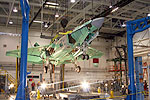Lockheed Martin F-35 Navy Jet Confirms Carrier-Landing Strength Predictions
 FORT WORTH, Texas, June 23rd, 2010 -- A Lockheed Martin [NYSE: LMT] F-35C Lightning II carrier variant successfully completed testing in which it was dropped from heights of more than 11 feet during a series of simulated aircraft-carrier landings. The tests validated predictions and will help confirm the F-35C's structural integrity for carrier operations.
FORT WORTH, Texas, June 23rd, 2010 -- A Lockheed Martin [NYSE: LMT] F-35C Lightning II carrier variant successfully completed testing in which it was dropped from heights of more than 11 feet during a series of simulated aircraft-carrier landings. The tests validated predictions and will help confirm the F-35C's structural integrity for carrier operations.
The jet, a ground-test article known as CG-1, underwent drop testing at Vought Aircraft Industries in Grand Prairie, Texas. No load exceedances or structural issues were found at any of the drop conditions, and all drops were conducted at the maximum carrier landing weight. The drop conditions included sink rates, or rates of descent, up to the maximum design value of 26.4 feet per second, as well as various angles and weight distributions. The tests were used to mimic the wide range of landing conditions expected in the fleet.
"The completion of the drop tests is an important step in clearing the way for field carrier landing testing and shipboard testing at high sink rates –a necessary feature for a carrier-suitable strike fighter," said Larry Lawson, Lockheed Martin executive vice president and F-35 program general manager. "This testing also validates the design tools and analysis used in building a structurally sound, carrier-suitable fighter."
This final drop test follows the recent first flight of the first F-35C.
The F-35 program has about 900 suppliers in 45 states, and directly and indirectly employs more than 127,000 people. Thousands more are employed in the F-35 partner countries, which have invested more than $4 billion in the project. Those countries are the United Kingdom, Italy, the Netherlands, Turkey, Canada, Australia, Denmark and Norway.
Three F-35 variants are under development – the F-35A CTOL variant to replace U.S. Air Force F-16s and A-10s, as well as aircraft employed by seven allied nations; the F-35B STOVL variant to replace U.S. Marine Corps AV-8B Harriers and F/A-18s, U.K. Royal Air Force and Royal Navy Harrier GR.7s, GR.9s and Sea Harriers, and Italian Harriers; and the F-35C carrier variant to replace U.S. Navy F/A-18s.
The F-35 Lightning II is a 5th generation fighter, combining advanced stealth with fighter speed and agility, fully fused sensor information, network-enabled operations, advanced sustainment, and lower operational and support costs. Lockheed Martin is developing the F-35 with its principal industrial partners, Northrop Grumman and BAE Systems. Two separate, interchangeable engines are under development: the Pratt & Whitney F135 and the GE Rolls-Royce Fighter Engine Team F136.